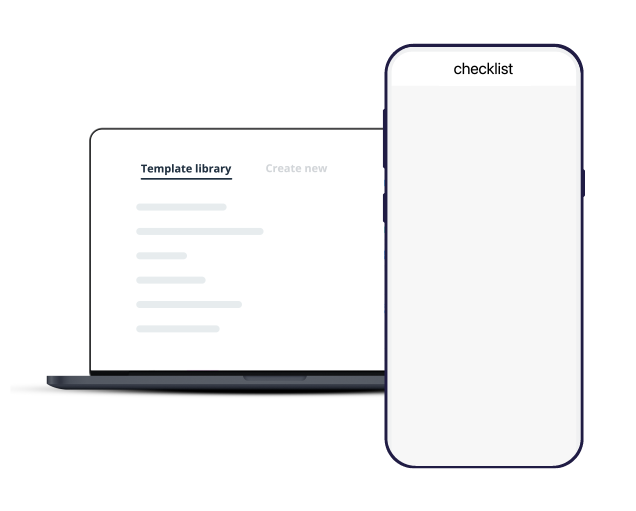Use our employee handbook template to effectively communicate your company’s mission, policies and expectations.
Employee Handbook Template

Make work flow with Connecteam’s digital forms & checklists
- Easily create digital forms and checklists for any task your team needs to complete on the job
- Boost accountability by having employees add a signature, image, or location stamp
- Save time by choosing from a variety of ready-made templates
- Instantly receive your team’s submissions and share reports within your organization
- Use AI to convert PDFs, Excel files, or images into digital forms in seconds—no manual work needed

Employee Handbook Template
An employee handbook is documentation prepares a new employee for their new job and respective responsibilities. However, it also helps employees get comfortable and feel welcome at your company.
What should be included in an employee handbook?
- Basics of Employment
- Workplace Policies
- Code of Conduct
- Compensation
- Benefits and Perks
- Working Hours, PTO and Vacation
- Resignation and Termination
Make sure your employee handbook is kept up to date and is accessible at any time for all your employees. Our employee handbook template is easy to fill out so that you can easily build the best employee handbook for your business. However, be sure to change the language to better match your company culture.
We recommend having legal counsel review your employee handbook before you make it public for your employees.
Employee Handbook Template
Basics of Employment
Welcome statement. Your new hire should feel excited about joining your company so take a moment to reflect on your company’s history (date founded, who the founders are, etc.). Especially discuss your mission statement and what your company culture.
The hierarchy chart. Present a clear organizational chart of everyone who works for the company, from the top to the bottom. Add pictures as well so new hires can put a face to the name.
Employee directory. Either make it a section all on its own or add the contact information of each employee under their name in the hierarchy chart. Or if you have an employee app, like Connecteam, let your employees know all contact information is stored on the app.
Employment contract types. Explain full-time and part-time positions. Include interns, seasonal staff and any other worker your company employs.
Equal opportunity employment. No not forget to include this section whatsoever, it’s a must for legal reasons but it also helps to create a positive company culture.
Recruitment process. Briefly explain how your company hires employees, like if you do pre-employment checks or have a referral rewards program. Be sure to clearly explain what each means.
Attendance. Employees should be crystal clear on what your employee attendance policy is. (You can also refer them to the Working Hours, PTO and Vacation section of the employee handbook for further information.)
Workplace Policies
Confidentiality and data protection. Include all the laws that are applicable to your company and how you adhere to them. Mention what employees should do in such cases.
Harassment and violence. Establish what your company considers harassment and what the repercussions are if someone violates the rules. You want to create respect, harmony and safety from harassment and violence in the workplace so make sure your employees know that.
Workplace safety and health. Outline how your company complies with occupational health and safety laws. Clearly define how you protect your employees in hazardous jobs or from emergencies. Include what the incident report forms are and how to file them.
Code of Conduct
Dress code. Even if you don’t have a proper dress code, outline what employees can and can’t wear. (You can also refer to our Dress Code Policy template for guidance).
Cyber security and digital devices. This covers the following: internet usage, company cell phones, corporate email and social media use (corporate and personal). The guidelines should allow for some flexibility but employees must follow the rules in place for the flexibility to continue.
Conflict of interest. Outline what constitutes a conflict of interest, what employees should do if they encounter one, and what the consequences are if someone breaks the relevant laws or company rules.
Employee relationships and fraternization. Employees are welcome to become friends or even date, however include a few rules in order to avoid gossip or an unprofessional scene.
Employment of relatives. You need to avoid accusations of nepotism and favoritism so be clear on what the working relationships are between relatives employed at your company.
Workplace visitors. Be clear on the guidelines for when an employee brings a friend or family member on company premises.
Solicitation and distribution. Discuss attempts by outsiders or employees to solicit or distribute flyers, products or services and include tips on how employees should handle these cases.
Compensation
Compensation and payroll. This usually applies for U.S. companies only, where they have laws on exempt and nonexempt employees, however you need to know if this applies to you. Detail the legal framework and overtime rules. Employees should know on what day, and how often (weekly, monthly, etc.) they receive their salary or wages.
Performance management. Employees need to understand how their performance is evaluated, and also prepare managers for their managerial duties. Mention objectives of performance reviews and how managers can lead their teams.
Employee training and development. Detail plans of employee retention so employees can improve personally and professionally. If there are training opportunities and education budgets, add them to this section.
Benefits and Perks
Employee health. If your company offers private health insurance, gym membership, wellness programs, etc., add it here. Mention the relevant laws, like FMLA and COBRA.
Workers’ compensation. If employees are injured at work, discuss what injuries are covered and what benefits you offer if it should happen.
Work from home. Detail how employees can receive the benefit of remote work and what rules to follow if granted (such as cyber security at home). Establish what the rules are for permanent remote workers.
Employee expenses. List the work-related expenses your covers and the process employees should follow to claim reimbursement.
Company car. Outline the process of getting a company car, what rules employees must follow, and what expenses are covered.
Parking. Employees should know how to manage their allocated space if you offer free parking. However, if there are limited spaces, detail the criteria to allocate the spaces.
Company-issued equipment. The equipment employees are given by the company, like phones, laptops, etc. should have clear guidelines in place – how to get the equipment, how to take care of it and what the process is if the equipment is damaged or stolen.
Working Hours, PTO and Vacation
Working hours and Paid time off (PTO). Detail the company-wide working hours and the expectations you have. List how many paid days off employees have and what the process to requesting PTO is.
Holidays. Include all holidays the company observes and how employees will be compensated if they work on these days.
Sick leave. Detail what the law obligates you offer employees and include extra sick leave benefits that you may offer. Define what constitutes as short-term and long-term illness.
Bereavement leave. Offer days (however many is determined by you) of bereavement leave to employees who have lost a loved one.
Jury duty and voting. List what the law is for employees called up for civic duties and what documents they need to present the company before, during and after fulfilling their civic duties.
Parental leave. What is the law for paternity and maternity leave and what documents are needed. If the company has additional guidelines for employees who have a baby or adopt one, include this. Include details of parental allowances, like leaving early to attend school meetings.
New pet leave (“furternity”). Employees who are new pet owners are allowed to work remotely for a week, or two weeks off paid leave, after they adopt a pet. You can choose how much time off employees get. This allows the new owner a chance to bond with their furry friend.
Resignation and Termination
Progressive discipline. Outline what the steps of your progressive discipline process are and how managers should handle it.
Resignation. Outline the process an employee needs to take if they want to resign, how much notice they need to give, what documents they need to fill out, and so on.
Termination. List the applicable laws and the company’s internal process when it comes to terminating employees. Outline conditions of severance pay and how employees will be compensated for remaining vacation days and sick leave.
References. If employees resigned or were terminated, include what the process is if, and how, you will offer a reference letter.
Related Templates:
Watch the video below to see it in action:

Ready to boost your efficiency with our pre-made templates?